
- Homepage
- Conflict
- Photo Type
- Album (7)
- Albumen (14)
- Ambrotype (195)
- Cabinet Photo (63)
- Cdv (445)
- Cdv & Tintype (6)
- Cdvs (3)
- Cdvs & Tintypes (7)
- Daguerreotype (78)
- Gelatin Silver (13)
- Mixed (3)
- Negative (10)
- Negative Photo (4)
- Opalotype (4)
- Other (4)
- Photograph (4)
- Stereoview (23)
- Tintype (497)
- Tintypes (3)
- Unknown (11)
- ... (5244)
- Signed
- Subject
- Children & Infants (21)
- Civil War (30)
- Civil War Soldier (12)
- Ethnic (17)
- Family (16)
- Fashion & Costumes (10)
- Figures & Portraits (146)
- Genealogy (10)
- Historic & Vintage (87)
- History (17)
- Men (54)
- Men, Civil War (47)
- Men, Military (34)
- Military (80)
- Military & Political (552)
- Military & War (14)
- Portrait (15)
- Portraits (14)
- Soldier (11)
- Women (16)
- ... (5435)
- Theme
- Americana (36)
- Americana, Art (4)
- Americana, Fashion (15)
- Americana, Militaria (16)
- Antique (7)
- Art (5)
- Civil War (14)
- Fashion (17)
- History (39)
- History, Militaria (8)
- Love (6)
- Militaria (899)
- Patriotic (6)
- People (19)
- Politics (11)
- Portrait (59)
- Portrait, Man (22)
- Stamps (17)
- Stereoview (5)
- Victorian (7)
- ... (5426)
- Type
- Belt Buckle (3)
- Carte De Visite (2)
- Cdv (3)
- Cdv Photograph (14)
- Daguerreotype (3)
- Full Cdv Photo Album (2)
- Negative Film Photo (4)
- Pendant (3)
- Photo Album (3)
- Photo Frame (2)
- Photograph (1193)
- Photograph Album (39)
- Picture Book (7)
- Picture Frames (8)
- Print (3)
- Real Photo (rppc) (8)
- Tintype (9)
- Tintype Photo (4)
- ... (5328)
Antique Unusual Ambrotype Paramilitary Wide Awakes Abe CIVIL War Era Ma Photo
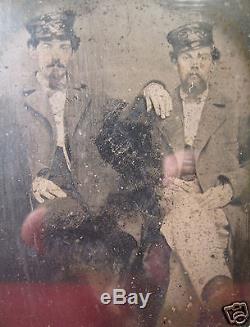
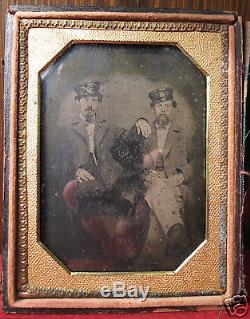
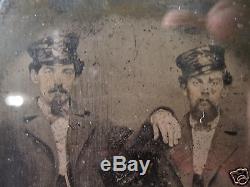
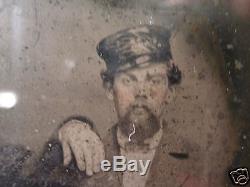
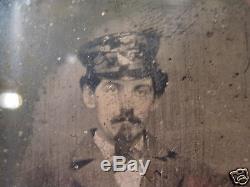
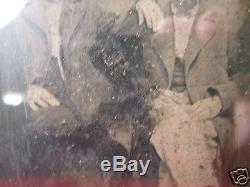
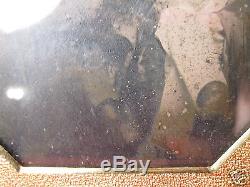
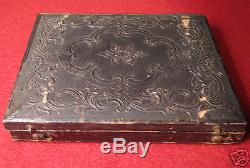
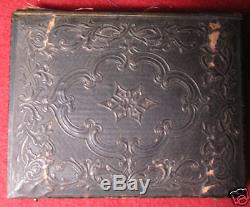
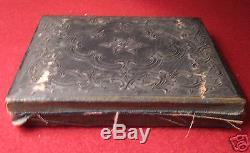
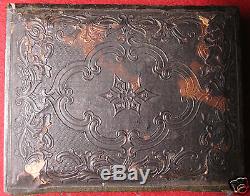
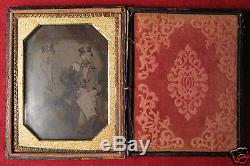


A quarter plate ambrotype measuring approximately 4 1/4 x 3 1/4 inches in a larger case who appear to be Wide Awakes based on their dress. Fine details with a few scratches on the glass and majority of image remaining. Complete original case with binding detached.
The Wide Awakes was a paramilitary campaign organization affiliated with the Republican Party during the United States presidential election of 1860. The "wide awakes" were typically young men, who marched for the Republicans in huge torch-lit parades, sometimes singing political songs. Lincoln, himself, coined the term for these supporters, according to The New York Times, saying in Hartford, Connecticut: The boys are wide awake.Suppose we call them the'Wide-awakes'. The standard Wide Awake uniform consisted of a full robe or cape, a black glazed hat, and a torch six feet in length to which a large, flaming, pivoting whale-oil container was mounted.
Similar organizations affiliated with the Democratic Party were called the "Douglas Invincibles", "Young Hickories" or "Earthquakes". Southern organizations were called the "Minute Men". In the mid-1850s, an entirely separate group called the "Wide Awakes" existed in New York City. This was a political club loosely associated with the Know Nothing movement.
In 1856, across the North, the new Republican party organized young men's marching clubs called "Rocky Mountain Clubs", "Wide Awakes", "Freedom Clubs", and "Bear Clubs" The term "Wide Awakes" became popular in the 1860 campaign. In Chicago on October 3, 1860, 10,000 Wide Awakes marched in a three-mile procession. The story of this rally occupied eight columns of the Chicago Tribune. In Indiana, as one historian reports, 1860 was the most colorful in the memory of the Hoosier electorate.
"Speeches, day and night, torch-light processions, and all kinds of noise and confusion are the go, with all parties, " commented the "independent" Indianapolis Locomotive. Congressman Julian too was impressed by the "contrivance and spectacular display" which prevailed in the current canvass. Each party took unusual pains to mobilize its followers in disciplined political clubs, but the most remarkable of these were the Lincoln "Rail Maulers" and "Wide Awakes, " whose organizations extended throughout the state. Clad in gaudy uniforms the members of these quasi-military bands participated in all Republican demonstrations. The "Wide Awakes" in particular were well drilled and served as political police in escorting party speakers and in preserving order at public meetings.Party emulation made every political rally the occasion for carefully arranged parades through banner-bedecked streets, torchlight processions, elaborate floats and transparencies, blaring bands, and fireworks. In 1860, the New York Herald estimated that there were over 400,000 drilled and uniformed Wide-awakes, nationwide. Its activities were conducted primarily in the evening and consisted of several night-time torch-lit marches through cities in the northeast and border states.
The Wide Awakes adopted the image of a large eyeball as their standard banner. Little is known about the national organization of the Wide Awakes, if indeed any formal governing body existed at all. The clubs seem to have been organized by city into local chapters. Surviving minutes of the Waupun, Wisconsin Wide Awakes chapter restrict membership to males age 18 and older.The member had to furnish himself with the style of uniform adopted by this Club. The chapter had a military-style officer system consisting of a Captain and 1st through 4th Lieutenants. The Captain shall have command of the Club at all times; in his absence the Lieutenants shall have command in the order of their rank.
Whatever their names marching clubs of both parties often had bands and fancy uniforms. Their worm fence march can be imagined, as can a nice connection to Lincoln as rail splittera connection that does remind us of the log-cabin and hard/ cider symbolism of earlier days [of 1840].
The more important connection to be made, however, is to the militia fever of the 1850s. Many Americans north and south delighted in military uniforms and titles, musters and parades, and the formal balls their companies sponsored during the winter social season. The regular campaign clubs, meanwhile, were given a different attraction. One of the first items of business, once the club was organized, was to invite the ladies to meetings. Many members were single young men, and the campaign occurred during a relatively slow social season following the picnics, steamboat excursions, and other outings of the summer, and preceding the balls sponsored by militia companies, fire companies, and fraternal lodges during the winter.Campaign clubs helped to extend and connect the social seasons for single young men and women, and gave both an occasion for high-spirited travel. Coming home there was fun, wrote the Democratic editor of a Dubuque Republican club excursion to a rally in Galena.
There were frequent three cheers for Miss Nancy Rogers. Captain Pat Conger was the best looking man on the ground and we can only say that it is a pity he is not a Democrat.
Typical Wide Awakes chapters also adopted an unofficial mission statement. The following example comes from the Chicago Chapter: To act as a political police. To do escort duty to all prominent Republican speakers who visit our place to address our citizens.
To attend all public meetings in a body and see that order is kept and that the speaker and meeting is not disturbed. To attend the polls and see that justice is done to every legal voter.
To conduct themselves in such a manner as to induce all Republicans to join them. To be a body joined together in large numbers to work for the good of the Republican Ticket. In August 1860 a political rally was scheduled to be held at Stone's Prairie in Adams County, Illinois, near the modern village of Plainville. This area, in far western Illinois, was familiar to two of the Presidential candidates.Although the Republican candidate, Abraham Lincoln, was known in the area, his Democratic opponent, Stephen Douglas, had practiced law nearby. In addition to local animosity, Adams County was close to the border with Missouri, a slave state. The rally was organized by the Republicans.
When it was initially announced, there was an invitation to Democratic speakers. Although the invitation was later withdrawn, this fact was not widely disseminated, resulting in confusion as to whether this was to be a Republican rally, or a debate between Republican and Democratic supporters. During the 1860 campaign, it was a common practice for settlements to raise poles, as much as 150 feet (50 meters) high. The political parties hung flags, and effigies of the candidates they opposed, from the poles. On the way to the rally, the Quincy Wide Awakes passed through Payson, the residents of which had erected a pole with an offensive effigy of Lincoln astride a rail.
The Wide Awakes, however, carried a banner with an equally offensive depiction of a drunken Douglas falling over a pile of rails. An early confrontation was avoided, with the Wide Awakes proceeding to Stone's Creek. The August 25, 1860, rally involved around 7000 participants.
Democrats appeared, expecting to hear their candidates in a debate. They were instead treated to a podium of Republicans, whom they heckled. The Wide Awakes defended the speakers, and a general melee resulted, involving several hundred men.Although Wide Awakes avoided confrontation, shots were fired at them while leaving town. The Wide Awakes' flag was pierced by shots, and several were reported to have been injured.
In 1860, Texas Senator Louis T. Wigfall alleged falsely that Wide Awakes were behind a wave of arson and vandalism in his home state of Texas.
Historians have found no evidence whatever of any such conspiracy, but they do report that in Texas, in 1860, a statewide hysteria over nonexistent slave revolts led to the lynching of 30-100 slaves and whites in the so-called Texas Troubles. The Wide Awakes never marched anywhere in the South, in 1860, but they represented the Souths greatest fear, an oppressive force bent on marching down to their lands, liberating the slaves and pushing aside their way of life.
Their outfits and equipment only further incited this fear with beliefs that they parade at midnight, carry rails to break open our doors, torches to fire our dwellings, and beneath their long black capes the knife to cut our throats. To the South, the Wide Awakes were only a taste of what was to come if Lincoln were to be elected. The North would not compromise, and would, if need be, force themselves upon the great South. One half million of men uniformed and drilled, and the purpose of their organization to sweep the country in which I live with fire and sword. This mindset was not appeased any by the wide acceptance of the Wide Awakes in the North.On October 25, 1858, Senator Seward of New York stated to an excited crowd, a revolution has begun and alluded to Wide Awakes as forces with which to recover back again all the fieldsand to confound and overthrow, by one decisive blow, the betrayers of the constitution and freedom forever. To the South, the Wide Awakes and, thus the North, would only be content when the South was fully dominated. The South recognized the need for their own Wide Awakes, and thus started a movement to create a counteracting organization in the South, dubbed the "Minute Men".
The South viewed the Wide Awakes as the Norths private army, and thus they determined on creating their own. They would no longer entertain the abhorrence of the rapine, murder, insurrection, pollution and incendiarism which have been plotted by the deluded and vicious of the North, against the chastity, law and prosperity of innocent and unoffending citizens of the South. [12] The Minute Men was the Souths unofficial army.
Like that of the Wide Awakes, they were expected to form an armed body of menwhose duty is to arm, equip and drill, and be ready for any emergency that may arise in the present perilous position of Southern States. The fear of the Wide Awakes resulted in Minute Men companies forming all over the South. Like their enemy, they too held torch rallies and wore their own uniforms, complete with an official badge of a blue rosetteto be worn upon the side of the hat. After Lincoln called out all the militia in April 1861, the Republican Wide Awakes, the Democratic "Douglas Invincibles", and other parade groups volunteered en masse for the Union army. In 1864, reports of political rallies note that "The Northwestern Wide Awakes, the Great Western Light Guard Band, and the 24th Illinois Infantry" were at a Chicago meeting.
On November 5, the Chicago Union Campaign Committee (the name of Lincoln's party that year) declared, On Tuesday next the destiny of the American Republic is to be settled. We appeal to Union men. We appeal to merchants to close their stores, manufacturers to permit their clerks and laborers to go to the polls, the Board of Trade to close, the Union Leagues and Wide Awakes to come out. The rebellion must be put down.
In early 1861, the Wide Awakes chapter of St. Louis became involved in paramilitary operations at the outbreak of the Civil War. Aided by Francis Preston Blair, Jr.
And army Captain Nathaniel Lyon, the St. Louis Wide Awakes smuggled armaments into the city and trained secretly in a warehouse. The purpose was to prepare them for defense of the federal St. Louis Arsenal, which Confederate supporters wanted to seize. Lyon employed his political connections through Blair to obtain an appointment as commanding officer over the arsenal and, having received his promotion, promptly moved the St.
Louis Wide Awakes into the arsenal under cover of night. Lyon's Wide Awakes, newly mustered into the Federal army, were used on May 10, 1861 to arrest a division of the Missouri State Militia near St. Louis in what would become known as the Camp Jackson Affair. As the captured militia men were marched toward the arsenal later that day a riot erupted in which scores of civilians were shot or killed. This event marked the effective beginning of Civil War violence in Missouri.
Source: wiki and Ithaca College. Get your own map of past buyers. The item "ANTIQUE UNUSUAL AMBROTYPE PARAMILITARY WIDE AWAKES ABE CIVIL WAR ERA MA PHOTO" is in sale since Wednesday, May 25, 2016. This item is in the category "Collectibles\Photographic Images\Vintage & Antique (Pre-1940)\Ambrotypes". The seller is "theprimitivefold" and is located in Villa Park, Illinois.
This item can be shipped worldwide.
- Original/Reprint: Original Print
- Listed By: Dealer or Reseller
- Signed?: Unsigned
- Date of Creation: Pre-1950
- Photo Type: Ambrotype
- Subject: Figures & Portraits
- Color: Black & White
- Framing: Matted & Framed
- Size Type/Largest Dimension: Small (Up to 7")
- Region of Origin: US

